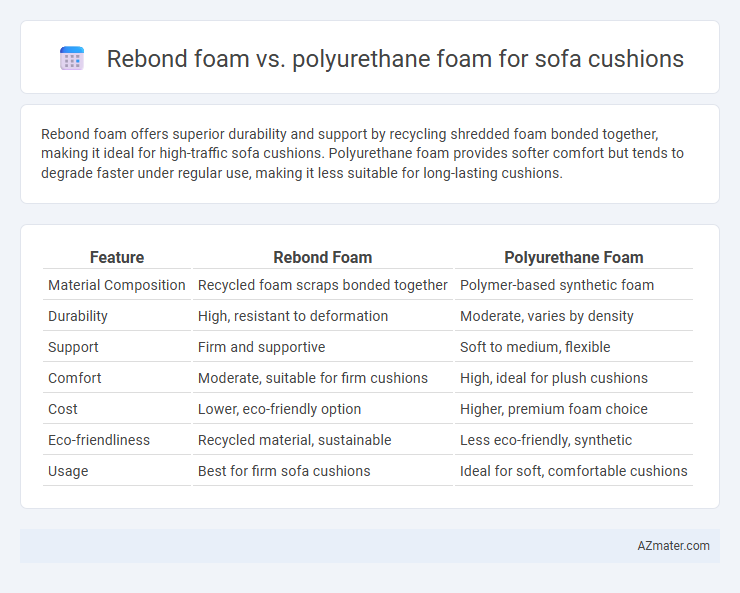Rebond foam offers superior durability and support by recycling shredded foam bonded together, making it ideal for high-traffic sofa cushions. Polyurethane foam provides softer comfort but tends to degrade faster under regular use, making it less suitable for long-lasting cushions.
Table of Comparison
| Feature | Rebond Foam | Polyurethane Foam |
|---|---|---|
| Material Composition | Recycled foam scraps bonded together | Polymer-based synthetic foam |
| Durability | High, resistant to deformation | Moderate, varies by density |
| Support | Firm and supportive | Soft to medium, flexible |
| Comfort | Moderate, suitable for firm cushions | High, ideal for plush cushions |
| Cost | Lower, eco-friendly option | Higher, premium foam choice |
| Eco-friendliness | Recycled material, sustainable | Less eco-friendly, synthetic |
| Usage | Best for firm sofa cushions | Ideal for soft, comfortable cushions |
Introduction to Sofa Cushion Materials
Rebond foam, made from shredded and reprocessed polyurethane foam bonded together, offers high durability and firm support, making it ideal for sofa cushions that require resilience and shape retention. Polyurethane foam, a versatile and lightweight material, provides varying levels of firmness and comfort depending on density and ILD (Indentation Load Deflection) ratings, commonly used for softer cushioning. Selecting between rebond foam and polyurethane foam hinges on factors such as desired firmness, longevity, and budget, influencing overall comfort and sofa performance.
What is Rebond Foam?
Rebond foam is a type of high-density foam made by bonding shredded polyurethane foam pieces together using adhesive and heat, resulting in a durable and firm material ideal for sofa cushions. This foam offers enhanced support and longevity compared to traditional polyurethane foam, which is typically made from a single piece of foam and can degrade faster under heavy use. Rebond foam's recycled composition makes it an eco-friendly choice while providing superior resilience and comfort in upholstered furniture.
What is Polyurethane Foam?
Polyurethane foam is a versatile, synthetic material widely used in sofa cushions for its excellent comfort and durability. It offers varying densities and firmness levels, making it adaptable to different seating preferences and support needs. Compared to rebond foam, polyurethane foam provides a softer, more resilient cushioning experience, ideal for everyday use.
Key Differences Between Rebond and Polyurethane Foam
Rebond foam, made from shredded polyurethane foam bonded together, offers higher density and durability, making it ideal for firm support in sofa cushions. Polyurethane foam is lighter and provides varying firmness levels, delivering softer comfort but less resilience compared to rebond foam. The key differences lie in durability, density, and support, with rebond foam excelling in longevity and polyurethane foam in cushioning softness.
Comfort and Support Comparison
Rebond foam offers superior durability and firm support for sofa cushions due to its dense, recycled foam composition, making it ideal for users seeking long-lasting comfort and resilience. Polyurethane foam, on the other hand, provides softer cushioning with excellent contouring properties, enhancing comfort by evenly distributing body weight for a plush seating experience. Comparing both, rebond foam maintains shape under heavy use, while polyurethane foam excels in softness and ergonomic support, catering to different comfort preferences.
Durability and Longevity Analysis
Rebond foam offers superior durability and longevity for sofa cushions due to its composition of shredded polyurethane foam bonded together, providing enhanced density and resilience against wear and deformation. Polyurethane foam, while comfortable and lightweight, tends to compress and lose its shape faster under regular use, making it less ideal for long-term durability. Choosing rebond foam extends the lifespan of sofa cushions by maintaining structural integrity and consistent support over time.
Cost and Value Considerations
Rebond foam is generally more cost-effective than polyurethane foam, offering durable support and higher density at a lower price, making it ideal for budget-conscious sofa cushions. Polyurethane foam, while often pricier upfront, provides superior softness and comfort, which can enhance long-term value for premium seating. Evaluating cost versus durability and comfort helps determine the best investment for sofa cushion materials.
Maintenance and Care Tips
Rebond foam requires regular vacuuming and occasional spot cleaning to prevent dust accumulation and maintain its durability, while polyurethane foam benefits from frequent fluffing and rotating to preserve its shape and prevent sagging. Both materials should be kept away from direct sunlight and moisture to avoid degradation, with polyurethane foam being more susceptible to wear if exposed to heat. Using removable covers on sofa cushions facilitates easy cleaning and extends the lifespan of both rebond and polyurethane foam cushions.
Best Uses for Each Foam Type
Rebond foam offers superior durability and firm support, making it ideal for sofa cushions in high-traffic areas or commercial settings where long-lasting performance is essential. Polyurethane foam provides excellent comfort and softness, perfect for residential sofas where plush seating and cushioning are prioritized. Choosing rebond foam suits applications requiring heavy use resistance, while polyurethane foam fits best in environments favoring cushioning and comfort.
Choosing the Right Foam for Your Sofa Cushion
Rebond foam offers superior durability and higher density, making it ideal for sofa cushions that require firm support and long-lasting comfort. Polyurethane foam provides a softer, more lightweight option with excellent cushioning but may compress faster over time compared to rebond foam. Selecting the right foam depends on your preference for firmness, durability, and budget, with rebond suitable for heavy use and polyurethane best for lighter seating needs.

Infographic: Rebond foam vs Polyurethane foam for Sofa cushion
 azmater.com
azmater.com